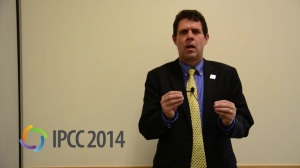Oral presentations can range from extremely formal (technical presentations to an external audience backed by a slide deck) to very informal (an oral report to a team in a meeting without any visual support). This page covers strategies for a variety of types of oral presentations and, along with our page on designing visuals, should help you develop this important part of your engineering communication toolbox.
Using a Storyboard to Plan a Presentation
How do you start a presentation? If you have looked for a strategy to plan an oral presentation, you might want to consider Storyboarding, an important technique for planning described by Melissa Clarkson in this post. This technique for developing the structure and content of a presentation helps take you away from slideware to start, so that you can see your presentation as a whole, allowing you to easily identify and re-organize the key content for your presentation.
Improving the Q&A Experience: A Collaborative Effort
How many times have you seen a smoothly delivered presentation with great slides and a clear and logical structure suddenly becoming disappointing or disastrous during the Q&A? Everyone has experienced a presentation Q&A session in which an over- enthusiastic presenter dives in with an answer before the audience member has finished what he or she wanted to ask. It is no surprise to find that the answer often has little connection to the question, and the whole interaction has to start again. What can we do as a presenter to improve the Q&A experience? Is there any way the audience members can help to make Q&A a more informative and interactive part of a presentation session? Read Laurence Anthony’s discussion of the important ways in which both presenters and audience members can work to improve the Q&A experience.
Audience Autonomy: Use It to Power Your Presentations
Some of your own powerful learning experiences may have happened when you had a chance to make choices, offer your own opinions, and take control of a process. That’s learner autonomy. And as a member of many presentation audiences, you probably have sensed when you would have welcomed a dose of autonomy! So the next time you are a presenter, how can you make audience autonomy a force in your—and your audience’s—success? In what ways can you build in opportunities for participants to make choices, offer opinions, and take control of steps in their learning? Read Pat Truman’s post on creating audience autonomy in presentations in order to find out how to create this dynamic and engaging environment in your presentations.
The Power of Presentations: Make Yours Informative, Persuasive, & Memorable
A webinar by Julia Williams, for the IEEE Robotics and Automation Society
Many engineers experience a kind of stage fright when they make presentations in front of groups, whether small or large. Their hands shake, their palms sweat, and they have a tendency to rock back and forth. But they may think there is nothing they can do about these physical tics. The success of an oral presentation depends on both the clear verbal information conveyed by the presenter and on the clear visual information conveyed by graphs, charts, tables, and other visuals. Unfortunately poor visuals can cause confusion when the presenter ignores the conventions of displaying information. How do you present technical information to non-technical people? Many engineers are tempted to “dumb down” technical content for non-engineers, often creating over-simplified presentations that insult the audience.
The Power of Presentations is a webinar designed to help you address these issues.
Download slides from the presentation
View the webinar recording
Michael Alley on Presentation Delivery in Engineering Contexts
|
At the IEEE PCS 2014 conference, Michael Alley, winner of the Ronald S. Blicq award for Distinction in Technical Communication, gave an engaging talk on the gap between what is expected of engineers in their professional presentations and what is taught in their classrooms, concluding with a need to revitalize teaching oral presentation delivery for engineers. … In a short interview following the talk, we asked him a few questions about giving presentations as an engineer.
|
 |
IEEE USA Webinar: That Bullet Is Not Magic – Avoid Presentation Mistakes and Create New Best Practices
In this workshop by Traci Nathans-Kelly, the focus will be on how to transform slides, used ubiquitously in engineering work. Slides are the stepping-off point that allows for a complete reconfiguring of how technical and engineering work (management, too) is shared, dispersed, and archived within organizations. These techniques are not theoretical—they are being used successfully in engineering firms around the globe. By the end of this workshop, you will have some new techniques, easily adaptable to your organization, that will enable your and your work to shine.
Download the slides from the presentation
View the webinar recording

